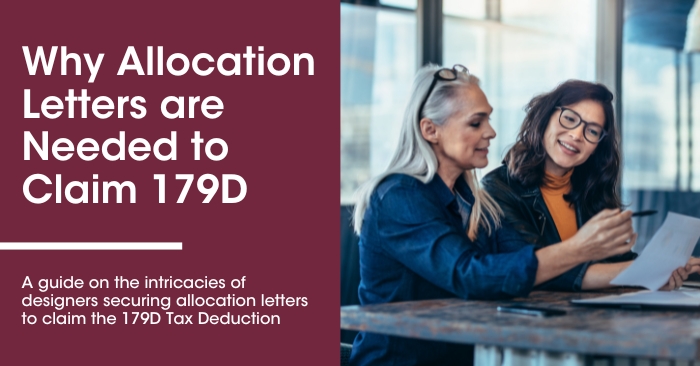By Jillian Jones, Director – Green Building Tax Incentives
Architects and designers play a crucial role in creating energy-efficient, tax-exempt buildings, and many need to be made aware of how the government rewards those that contribute to constructing energy-efficient projects with various Green Building Tax Incentives. Through programs like 179D Tax Deduction, eligible candidates can receive massive savings on their tax returns of up to $5.65 per square foot, by designing or renovating a heating and cooling system, interior lighting system, or building envelope and insulation systems that reduce a building’s energy consumption.
For designers of qualified buildings to claim 179D, the owner of the building must allocate the Deduction to one of the various designers involved through an allocation letter process. This document outlines how the 179D Deduction will be allocated to the eligible parties that designed and constructed the energy-efficient building based on their respective contributions to the project.
Components of an Allocation Letter
As a comprehensive document that contains specific information to validate a building’s qualification for 179D, there are many components of an allocation letter that must be presented to the IRS. KBKG has listed some of the key components below that the IRS looks for in an allocation letter when a claim for 179D has been submitted.
- Project Description: A detailed report of the eligible energy-efficient building, which includes the building’s location, cost, and dates of construction or renovation
- Involved Parties: The names and contact information of all the designers (architects, engineers, contractors, etc.) involved in the project that are filing a 179D claim
- Distribution of 179D: Specific documentation as to how the Deduction will be distributed amongst the various designers and at what proportions they will claim. Certain designers may take a larger share of 179D based upon their contributions to the project, and must sign to acknowledge the agreement and terms of the allocation
The Significance of Allocation Letters
An allocation letter must be secured for architects, engineers, design-build contractors, or other designers seeking to claim the Deduction. KBKG has outlined below some of the significant factors as to why securing an allocation letter is important.
- Legal Requirement: The IRS mandates the use of an allocation letter to substantiate claims for the 179D Tax Deduction. Failing to provide documentation of a properly secured allocation prevents any designer from claiming a benefit.
- Define Responsibility: Allocation letters specifically state who is responsible for claiming the Deduction, outlines the roles and responsibilities of all parties involved, and confirms distribution of the benefits
How the IRA Expanded Eligible Projects
Prior to the signing of the Inflation Reduction Act (IRA) in 2022, architects, engineers, and design-build contractors were only eligible to receive allocations for 179D on projects designed for local, state, and federal government-owned buildings. However, the IRA now allows designers of nonprofit and other tax-exempt buildings to also qualify for 179D for projects completed on or after January 1, 2023. KBKG has listed the eligible tax-exempt buildings below:
- Charitable organizations
- Churches & religious organizations
- Private schools and universities
- Private foundations
- Political organization
- Native American Tribal Governments
- Alaska Native Corporations
- Other Non-profits
There are many complexities of securing allocation letters and effectively claiming the 179D Tax Deduction. For years, KBKG has educated designers of government-owned and tax-exempt buildings by creating a clear path to claiming 179D and setting clear expectations. With an in-house, multidisciplinary team of tax professionals and licensed engineers, those interested in learning more about how to claim the 179D Tax Deduction should contact an expert at KBKG.


